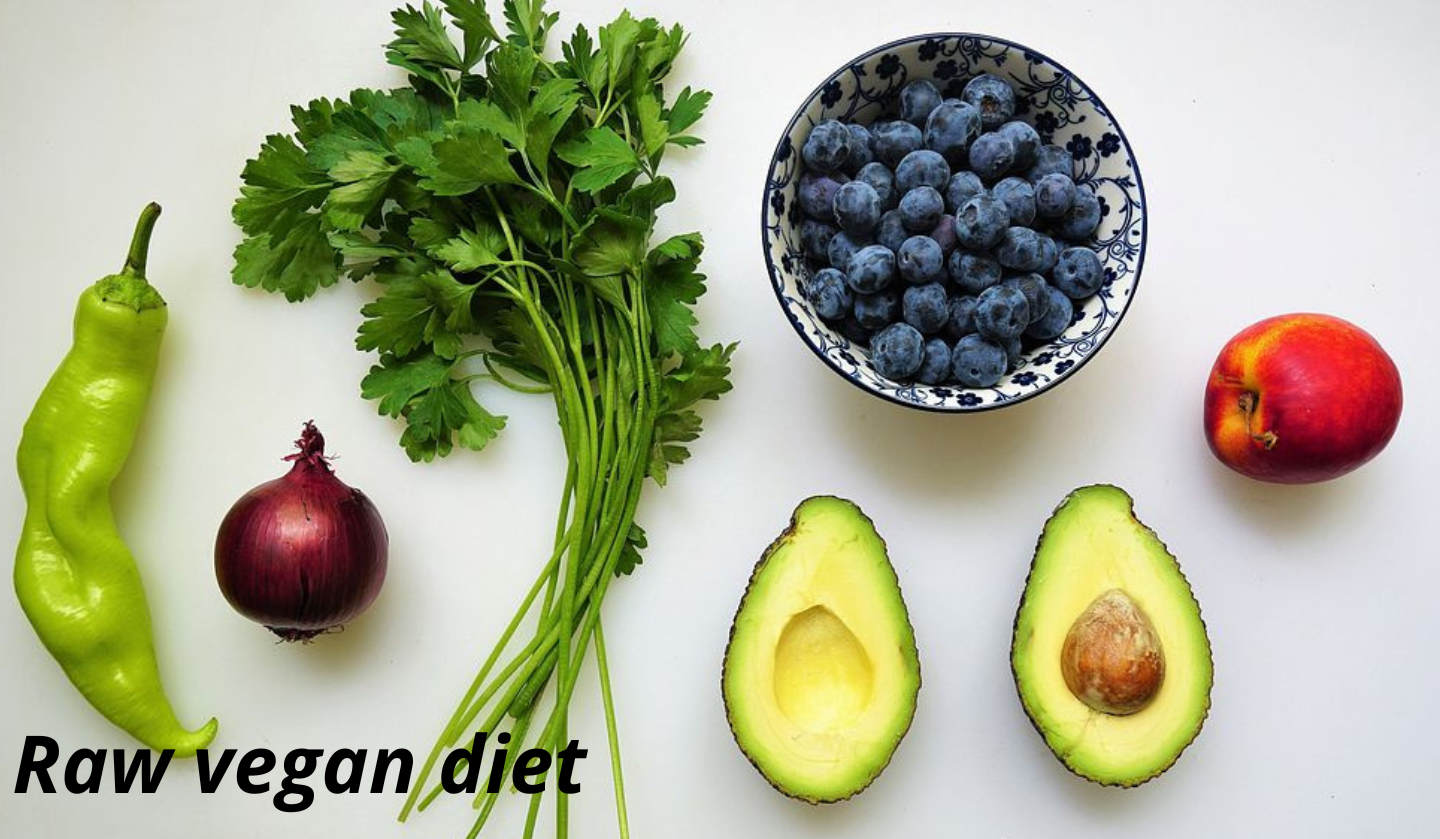Table of Contents
ToggleWhat Is a Raw Vegan Diet?
Raw Vegan Diet: A way towards Health and Simplicity
Introduction
The raw vegan diet is considered a lifestyle involving fresh, uncooked, plant-based eating. A part of many health benefits is well known due to their high digestion abilities, fullness of energy, and successful weight regulation.
People with raw vegan diet eat fruits, vegetables, nuts, seeds, and grains in raw, noncooked form because cooking destroys certain natural food enzymes and nutrients by heat, and the natural diet without cooking would benefit them to have optimal intake of vital nutrients.
This guide will take you through everything you should know about the raw vegan diet—from what to eat to how to get started. Let’s dive into why the raw vegan diet could be an excellent choice for you.
1. What is the Raw Vegan Diet?
The raw vegan diet is a plant-based diet where everything that is consumed is eaten raw or slightly heated but not cooked. People on this diet avoid all animal products, focusing instead on fresh fruits, vegetables, nuts, seeds, and sprouted grains. Not cooking the food preserves more nutrients and natural enzymes, according to raw vegans, and these enzymes can facilitate digestion and health.
In this diet, one eats:
Apples, bananas, oranges, and berries for fruits,
Carrots, cucumbers, and leafy greens for veggies,
And almonds, chia seeds, or sunflower seeds for nuts and seeds. Buckwheat and quinoa qualify as sprouted grains, so include that too.2. Benefits of the Raw Vegan Diet
Everyone takes the raw vegan diet for health concerns.
Let’s talk some of those advantages now.
For a start, the process of digestion of raw food is greatly improved since its content is abundantly nutrient-dense. Fresh fruits and vegetables contain vitamins, minerals, and antioxidants.
3. Everyday Foods in a Raw Vegan Diet
What to eat on a raw vegan diet? Some of the popular choices include the following: Fruits: bananas, apples, berries, oranges, and mangoes. Vegetables: leafy greens, bell peppers, tomatoes, carrots, and cucumbers. Nuts and seeds: almonds, walnuts, chia seeds, flaxseeds, and sunflower seeds. Sprouted grains: Buckwheat, quinoa, and barley. Healthy fats: avocados, olives, and coconut.
These foods are easy to find and extremely versatile, which can be eaten all alone, blended into smoothies, or crafted into raw dishes with simple and creative ingredients.
4. Starting Your Raw Vegan Diet
It can be daunting in the beginning to start a raw vegan diet; however, simple steps can make it easy enough. Here are some pieces of advice for beginners :
Start slow: Replace one meal a day with raw vegan. For instance, you can have a fruit smoothie for breakfast.
Try simple recipes: You can begin with simple meals such as salads, fruit bowls, and raw snacks.
Stock your kitchen: Ensure your fridge is always stocked with fresh fruits, vegetables, nuts, and seeds. A good blender can be very handy for smoothies and sauces.
These steps can make the raw vegan diet less stressful and even fun to transition into.
5. Sample Meal Plan for a Raw Vegan Diet
A sample day on the raw vegan diet is included here as a guide:
Start off your day with a banana smoothie mixed with some spinach, and add some berries in. Have a mixed green salad for lunch that’s sprinkled with sliced avocado, cherry tomatoes, and sunflower seeds. In between meals, have some handfuls of nuts or fruits for snacks.
Dinner: Zucchini noodles with raw tomato and basil sauce.
This straightforward meal plan is balanced in nutrients and offers a broad range of nutrients. This meal plan is also easy to prepare, and it is flexible.
6. Key Nutrients on a Raw Vegan Diet
On any diet, getting all key nutrients is important. Here’s how to get essential nutrients on a raw vegan diet:
Protein: Many people believe plant-based diets are low in protein, but raw vegan foods like nuts, seeds, and leafy greens are high in protein. Almonds, chia seeds, and kale give your body the protein to help build muscle and repair cells.
Iron: The nutrient iron, an element of energy as well as to the healthiness of your blood, is supplied in significant amounts by foods like spinach and kale that are deep green in colour, and seeds and dry fruits such as apricots. Mixing your iron-rich food with citrus fruits like orange makes them easier for the body to digest.
Calcium: Most foods are raw foods, and their source of supply is usually calcium for robust bones, and some other sources can be almonds, leafy greens, or sesame seeds.
Vitamin B12: These are generally found in an animal-based diet, so their raw vegan diet may involve supplementation of this vitamin B12 for nerve health as well as energy.
Omega-3 Fatty Acid: This is a category of healthy fats that decrease inflammation and are good for a healthy heart. Raw-vegan sources of Omega-3s include, but are not limited to, chia seeds, flaxseeds, and walnuts.
Here is the list of foods from where you can get all those essential nutrients required by the human body for a healthy body: Include all of them in your raw vegan diet.
7. Challenges and Tips on Raw Vegan Diet
As said earlier, every diet contains some challenge. The raw vegan diet is no exception either. Here are some of the common problems that face the person having this diet, along with some helpful tips that overcome the challenges.
Eating out: Most restaurants hardly have raw vegan dishes in their menus, but generally, there is a good salad or fruit plate prepared fresh. Whenever you must dine out, take a glance at the list of salads that are also vegan or ask them if they can prepare something accordingly.
Cooking your meals: All the raw food is very light and easy to prepare because some of the recipes require some preparation in advance, like you must prepare washed and chopped vegetables or nuts and seeds for speedy snacking.
Seasonal food access: Eat seasonally. Fresh fruits and vegetables taste better and may be cheaper. Visit local markets for seasonal produce.
Preparing meals in advance and keeping snacks like fruit, nuts, or homemade energy bars ready may make it easier to stick to the raw vegan diet.
8. Raw Vegan Diet Myths
The raw vegan diet is sometimes misunderstood. Here are a few common myths, along with the facts:
Myth 1: It is difficult to get enough protein. Fact: The raw vegan protein sources come in many shapes and forms. Nuts and seeds are often known for having a lot of protein, and there’s surprise amounts in the leafy greens and sprouted grains.
Myth 2: It only consists of salads. Fact: It is not made up purely of salads, which has been one common misconception from people. Besides salads, raw vegans also feast on smoothies, soups, energy balls, and dehydrated snack.
Myth 3: It’s radical and too limiting. Fact: This diet does seem restrictive, yet it encompasses such tremendous diversity of food and flavor. It could be plausible and fun once you know how.
These explanations light the way that the raw vegan diet need not be rigid, wholesome, and less limiting after all.
9. FAQ on the Raw Vegan Diet
For new followers of the raw vegan diet, here are some common FAQs:
Can I cook a little and still be considered on a raw vegan diet? From a purely technical sense, a raw vegan is an individual who only eats uncooked food, but actually, people eat almost exclusively raw and yet have some cooked products. The point is just to see what you find works best for you.
If you have never had any experience with veganism, where do you begin? You can start by gradually adding more raw foods to your diet. Try raw breakfasts or snacks before you try to move to full meals. You can slowly get used to it without completely overhauling your diet.
Do I need special equipment?
You want a blender and a food processor. Those make things that are quick, smooth, and sauce-like or soupy. Dehydrator is optional, but I love my dehydrator for raw snacks, like kale chips.
Through answering the above questions, the raw vegan diet is much less intimidating and easier to grasp.
Conclusion
The raw vegan diet is focused on uncooked, plant-based foods. You can enjoy many health benefits from better digestion, increased energy, and improved skin health by choosing raw fruits, vegetables, nuts, seeds, and sprouted grains. It’s easy to start this diet: begin slowly, choose easy recipes, and make sure you’re getting essential nutrients. The raw vegan diet does not have to be complicated or restrictive; just focus on fresh, wholesome foods.
A raw vegan diet can be just the ticket for anyone looking for a healthy and easy-to-follow diet.





Awesome